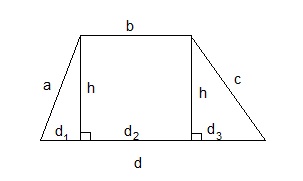How do you find the area of a trapezoid when you have the length of every side but not the height?
1 Answer
Let's say that you have the length of every side and they are named

The formula to compute the area of trapezoid is:
so basically the only thing we need to do is computing
If you draw the height
However, we also have two right angle triangles, one with the legs
So, we know three things (with the known values marked in
-
#color(white)(xxx) d_1 + d_3 = color(green)(d) - color(green)(b)# -
#color(white)(xxx) d_1 ^2 + h^2 = color(green)(a^2)# (theorem of Pythagoras) -
#color(white)(xxx) d_3^2 + h^2 = color(green)(c^2)# (theorem of Pythagoras)
Now, you can solve the equation in 1. for e.g.
Afterwards, the equations can be solved, and you will get the values for
And as soon as you have
Please also check here an example where I've done exactly the same calculation on concrete values. :-)

